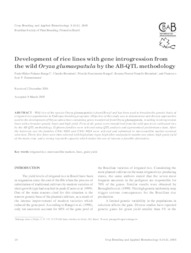Development of rice lines with gene introgression from the wild Oryza glumaepatula by the AB-QTL methodology.
Development of rice lines with gene introgression from the wild Oryza glumaepatula by the AB-QTL methodology.
Author(s): RANGEL, P. H. N.; BRONDANI, C.; RANGEL, P. N.; BRONDANI, R. P. V.; ZIMMERMANN, F. J. P.
Summary: Wild rice of the species Oryza glumaepatula is found Brazil and has been used to broaden the genetic basis of irrigated rice populations in Embrapa breeding programmes. The objective of this study was to demonstrate and discuss approaches used in the development of Oryza sativa lines containing genes transferred from Oryza glumaepatula, resulting in introgression lines with a broader genetic basis and high yield. First of all, genes were transferred from the wild species to cultivated rice by the AB-QTL methodology. Eighteen families were selected using QTL analysis and agronomical performance data. After the heterosis test, the families CNAi 9020 and CNAi 9024 were selected and submitted to microsatellite marker-assisted selection. Thirty-five lines were then selected with high plant vigour, high tiller and panicle number per plant, high grain yield of the main crop, and a strong regrowth capacity which makes the use of ratoons a feasible alternative.
Publication year: 2005
Types of publication: Journal article
Unit: Embrapa Rice & Beans
Observation
Some of Embrapa's publications are published as ePub files. To read them, use or download one of the following free software options to your computer or mobile device. Android: Google Play Books; IOS: iBooks; Windows and Linux: Calibre.
Access other publications
Access the Agricultural Research Database (BDPA) to consult Embrapa's full library collection and records.
Visit Embrapa Bookstore to purchase books and other publications sold by Embrapa.

